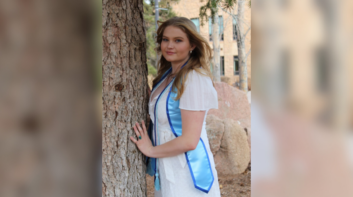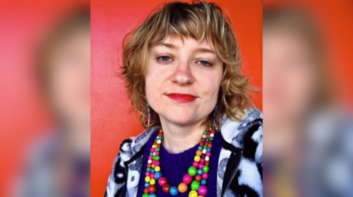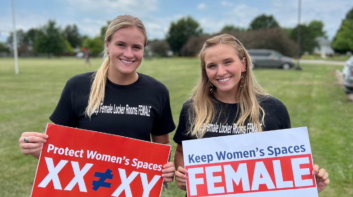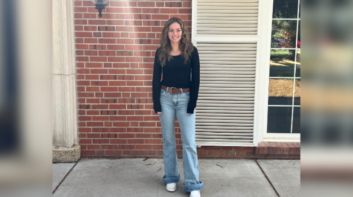Six-year-old Malachi Wright needed speech therapy from a young age to learn to talk, and then to improve his articulation. When it came time to enroll him in preschool, his mother, Elizabeth Wright, had the option of taking him to Mesa, Arizona’s free, public developmental preschool. However, that school offered only minimal one-on-one work with speech therapists — and Malachi would have been taught by teachers whose mouths were obstructed by face masks.
“Seeing the therapist’s mouth is incredibly vital for speech therapy, but it’s important all the time for children — especially those with speech needs,” Wright said. “If he was going to be in a classroom, I wouldn’t want him to not be able to see his teachers’ mouths. I also was happy to keep him home so he didn’t have to wear a mask, which would further impede his ability to communicate, given his trouble with articulation.”
Reluctant to enroll her young, barely-verbal child there, Wright discovered that Malachi qualified for Arizona’s Empowerment Scholarship Account (ESA) program due to his speech disabilities. Now that she can use Malachi’s ESA funds for one-on-one private speech therapy, her son has experienced significant communication improvements.
“I don’t doubt that the public school has great therapists, but there’s no question that individualized therapy and allowing him to be home at other times have been a far superior solution for my child,” Wright said.
From a financial perspective, Wright said that funds from Arizona’s ESA program were the only way for her child to have private speech therapy. To qualify for ESA funding in the past, students would need either a Multidisciplinary Education Team(MET) report, a 504 Plan, or an Individualized Education Program(IEP). Malachi had an IEP due to his developmental delays, but the funding for preschoolers was typically lower for K-12 students. As a result, Wright had limited program funds left over to afford at-home school curriculum after she paid for speech therapy.
Wright considered re-enrolling Malachi into public school for the first grade. However, when teachers at the local public school recommended he be held back and enrolled as a kindergartener, Wright decided to homeschool instead.
Since Wright previously worked as a public school teacher, she said she understood why the school wanted Malachi to stay back one year to comfortably function in a classroom. However, instead of letting her son be held back academically, Wright took matters into her own hands and is now a fully-equipped homeschool mom. Though Wright originally sought ESA funds for Malachi’s speech therapy, as time went on, she discovered that homeschooling better suited her son’s learning style.

For example, Wright gets one-on-one time at home with her son using multi-use wooden manipulatives for concrete understanding of concepts. She has found that modeling products similar to LEGOs increase his understanding of sequences, spatial reasoning and strengthen his fine motor skills. Then, Wright uses the objects he creates as a subject of study, like a famous piece of architecture, the parts of a flower, law enforcement services, or rocket ships as Wright shared that Malachi is currently very interested in astronauts and understanding what humans are doing in outer space.
After Arizona opened up universal student eligibility to its ESA program in 2022, families now have access to greater and more flexible funding to customize their children’s education. “[With the current ESA program] I am able to cover Malachi’s ongoing speech therapy needs as well as his core curriculum, supplemental materials, and elective studies,” she said. “Before [universal] ESA funding, I didn’t think I could carve out space for home educating my children, because I would be too overwhelmed with creating curriculum. I didn’t feel our financial situation was sufficient for me to spend larger amounts of money on the more-easily-followed ‘open and go’ curriculum that I was more comfortable using.”
When it comes time for his younger sister, Lucia, to enter kindergarten next fall, Wright said that she will apply for Lucia to access ESA funds so that both children can be homeschooled together.

“ESA gives me a sense of security that I can pay for the help I might need educating my children, since I’m learning how to educate them well,” Wright said, calling the program “life-changing.”
In addition to his younger sister Lucia, Malachi has three older siblings who attended public school. But, thanks to Elizabeth’s boost of confidence from homeschooling Malachi, as well as Arizona’s ESA program opening up universally to all students, Wright is also considering pulling her eldest daughter and son out of public school and enrolling them in the ESA program as well.
“We know that no two children have the exact same needs, and a standardized education often pushes aside those who don’t fit the mold, or crushes their spirits until they do fit the mold. I’ve witnessed both happen,” said Wright. “As parents support each other in exploring these opportunities, we prepare the way for further improvements where children of all neurodiversities can find joy and excitement in learning, and use that knowledge to better the world around us.”










